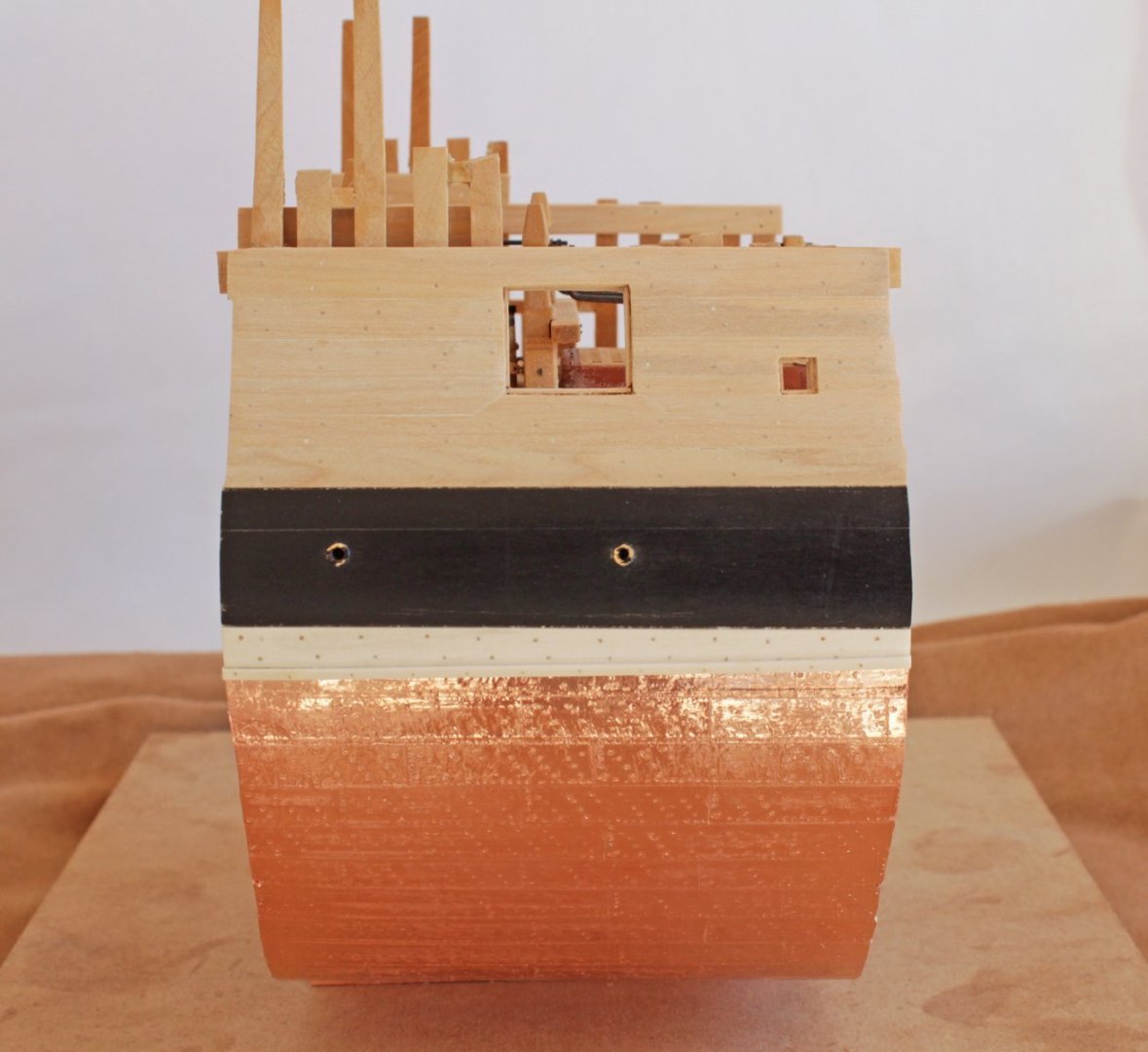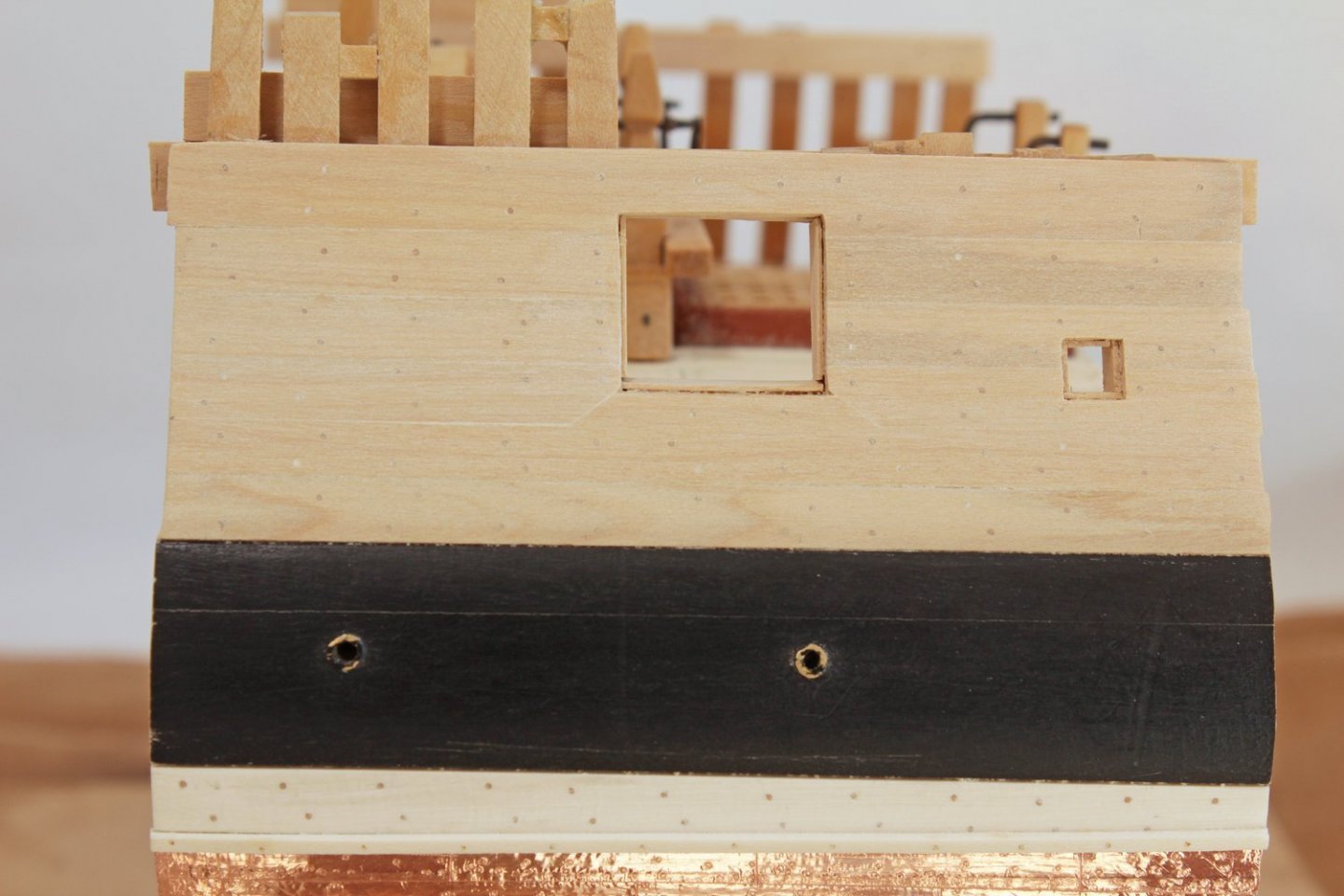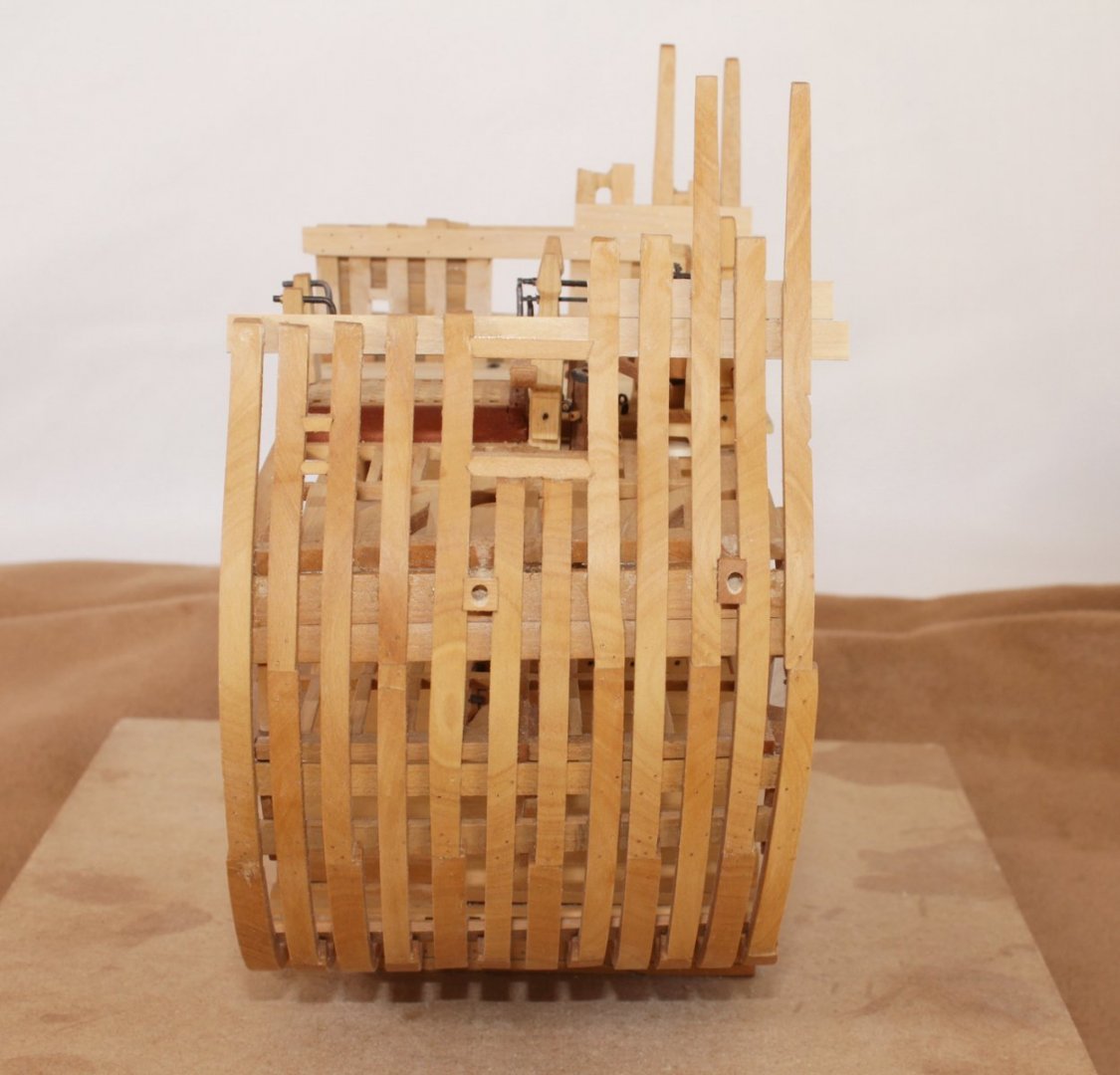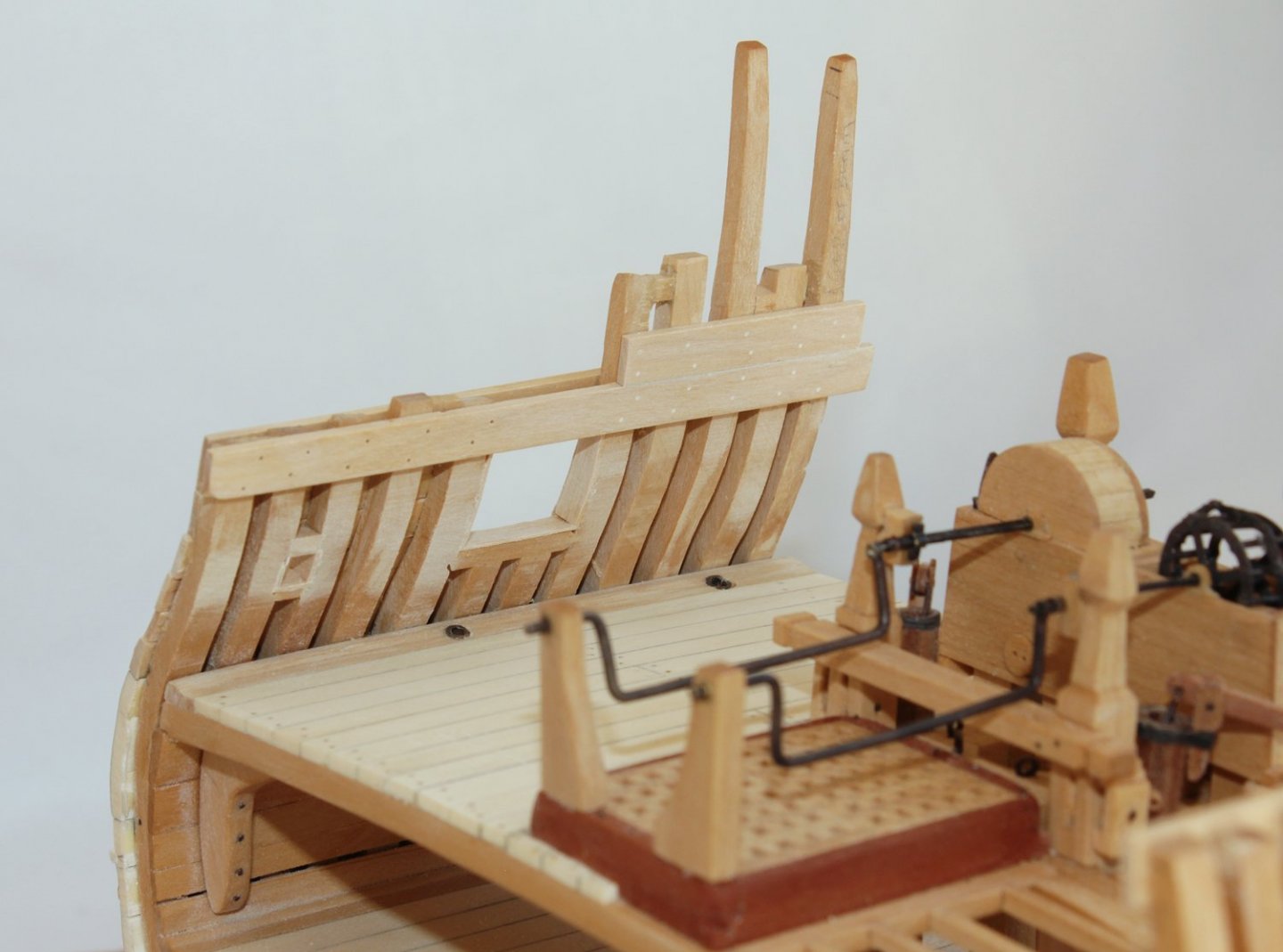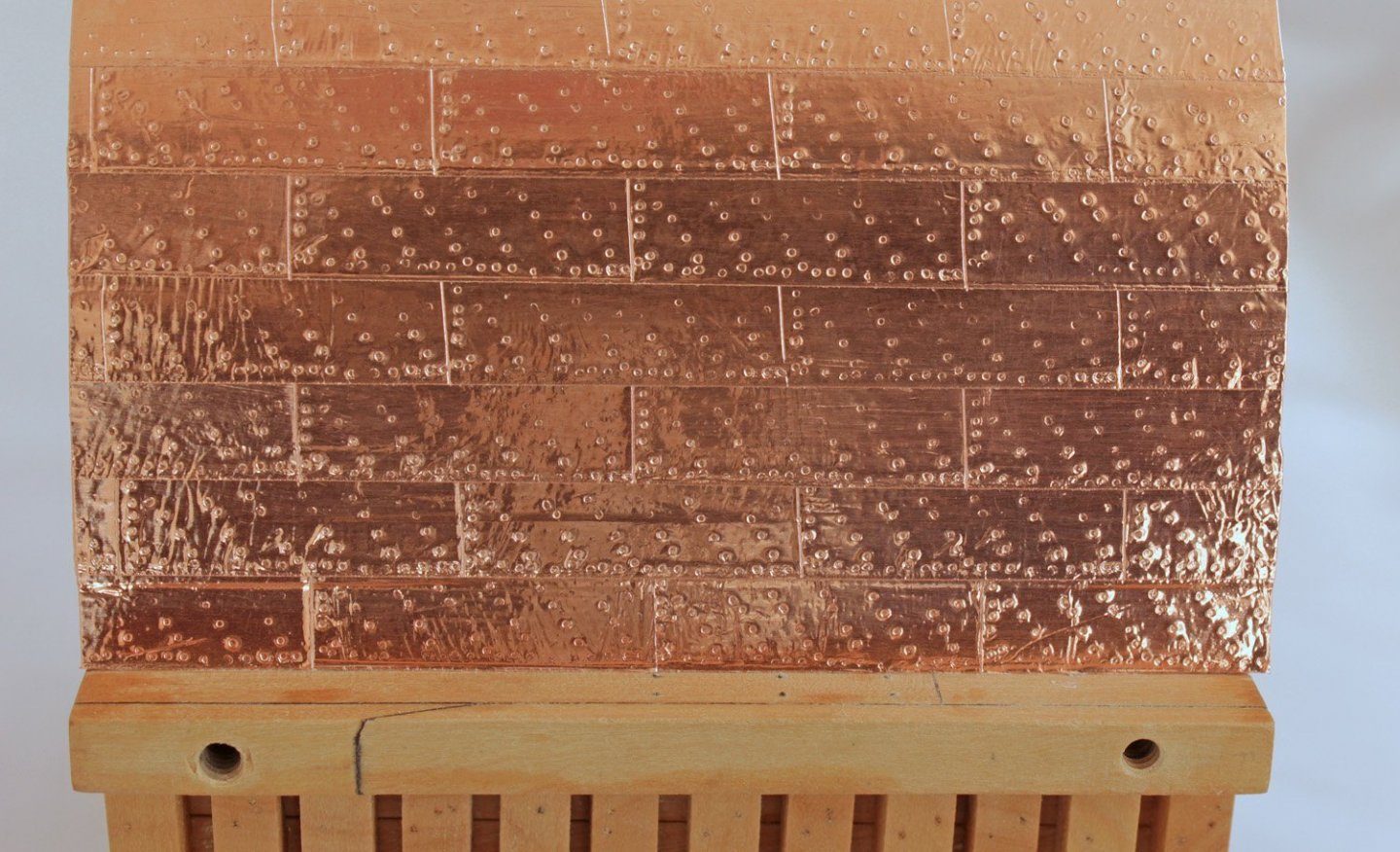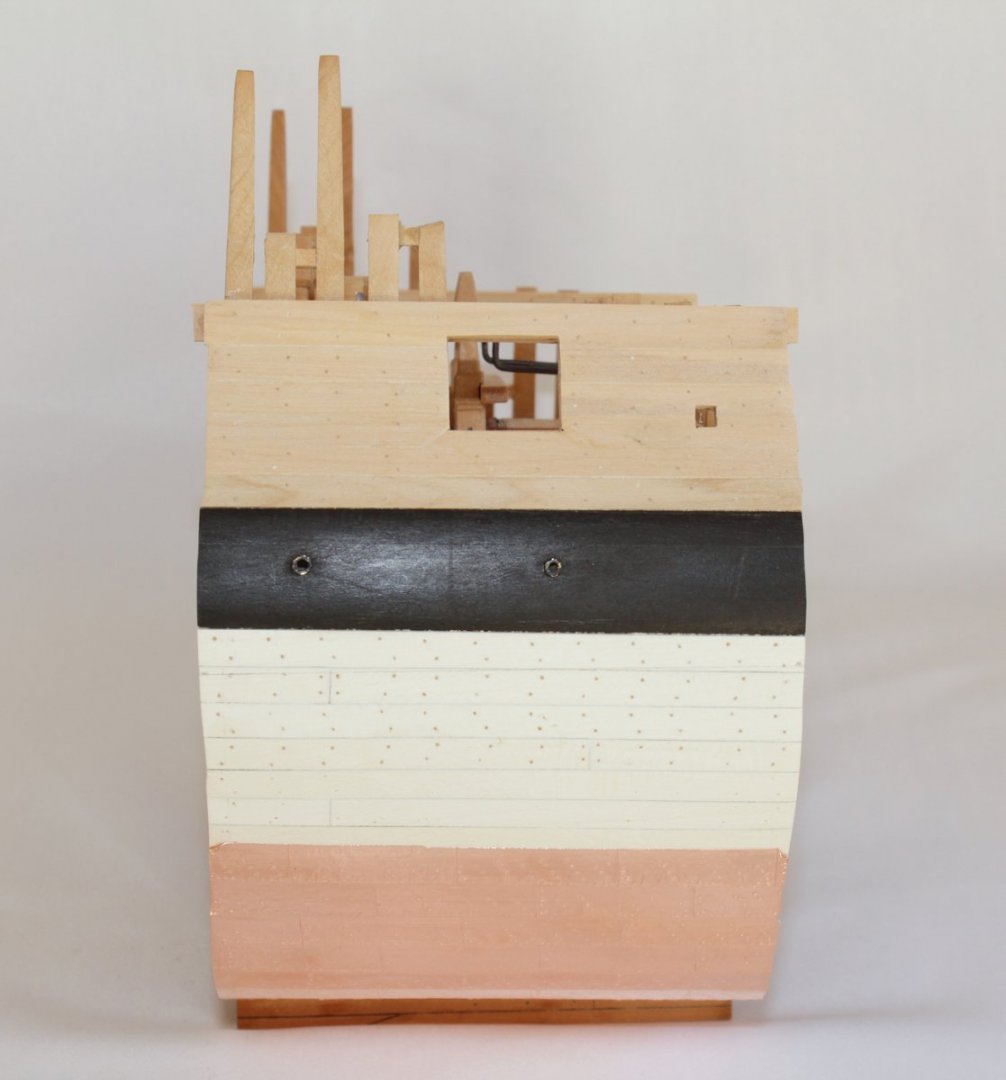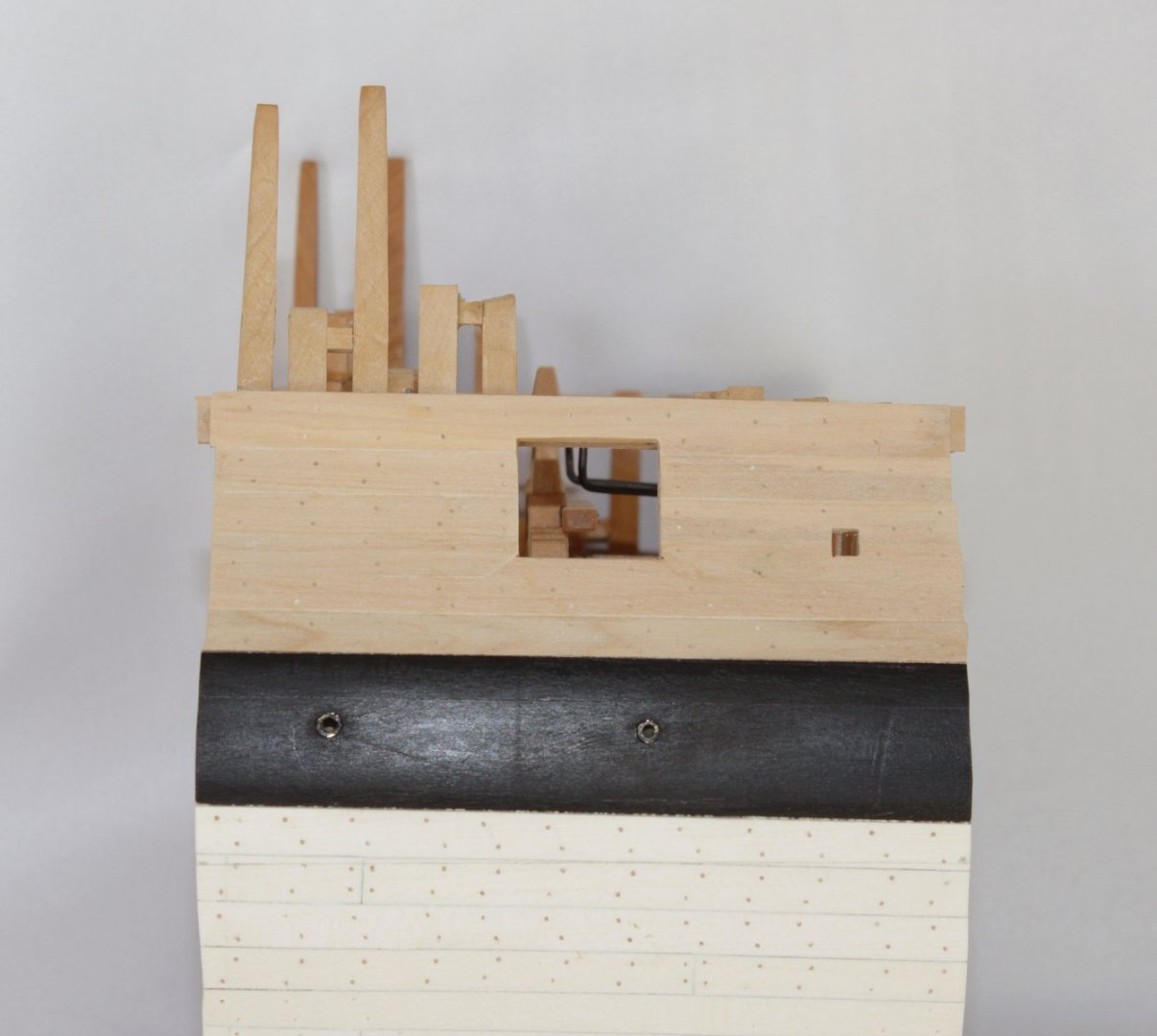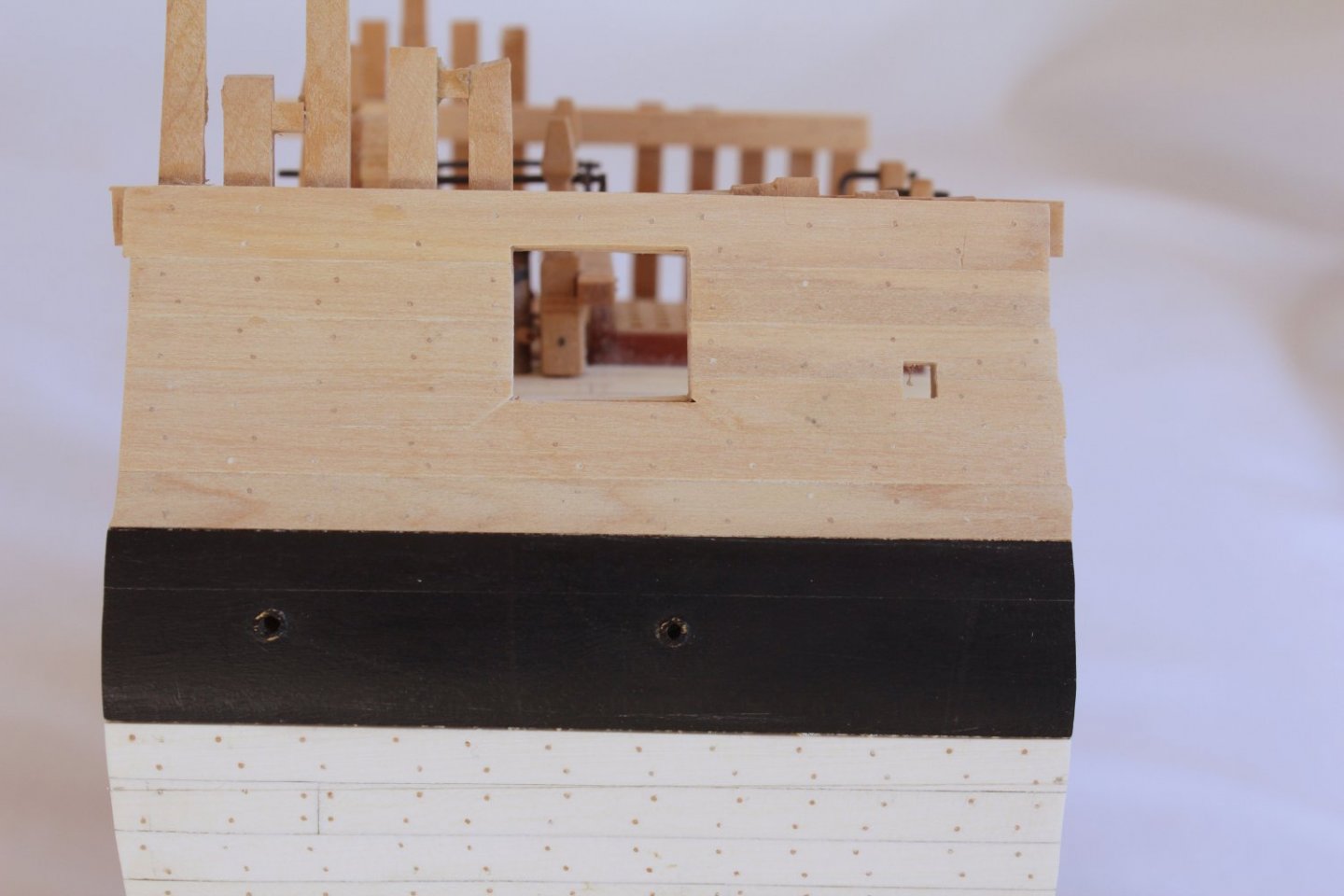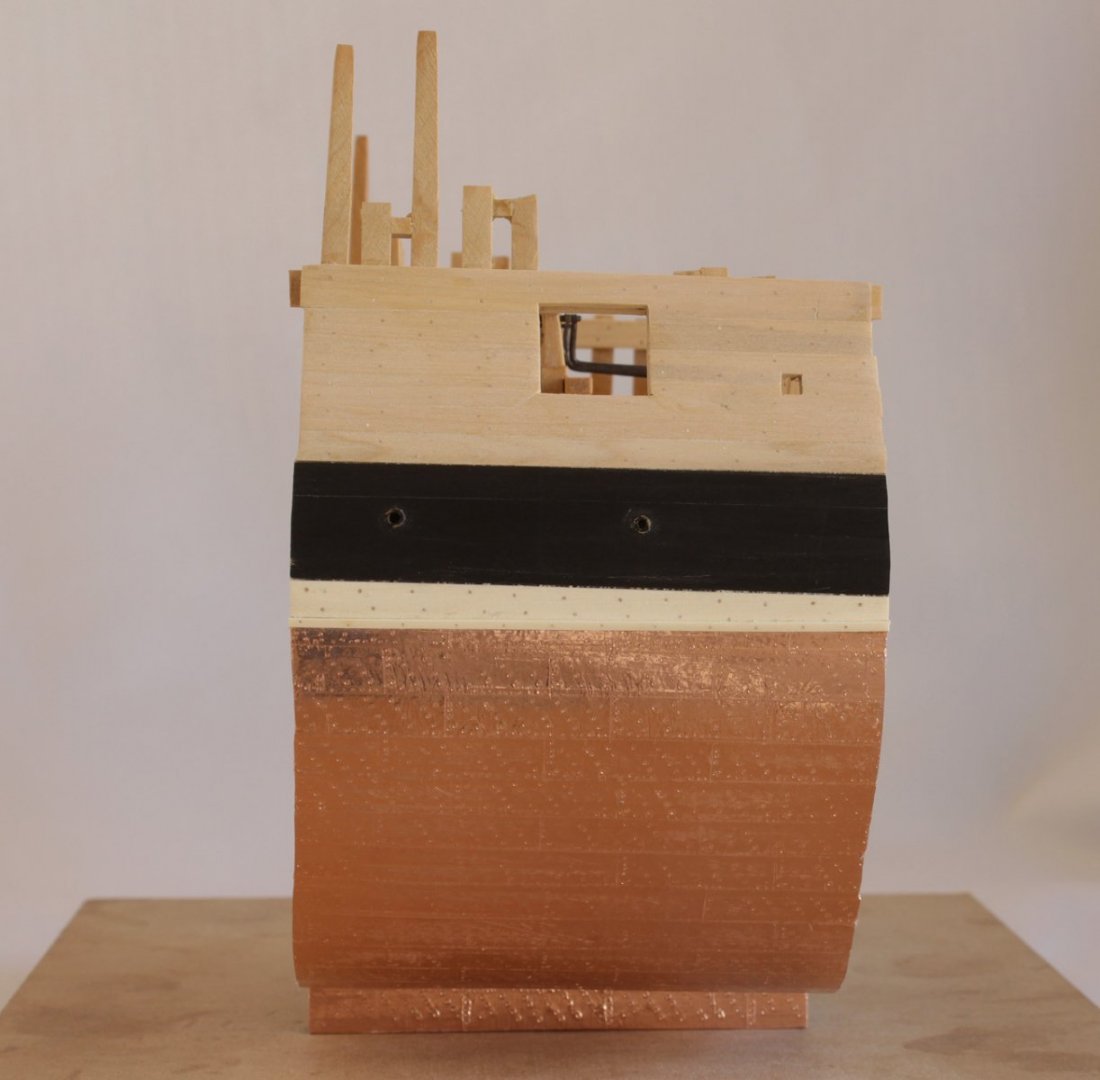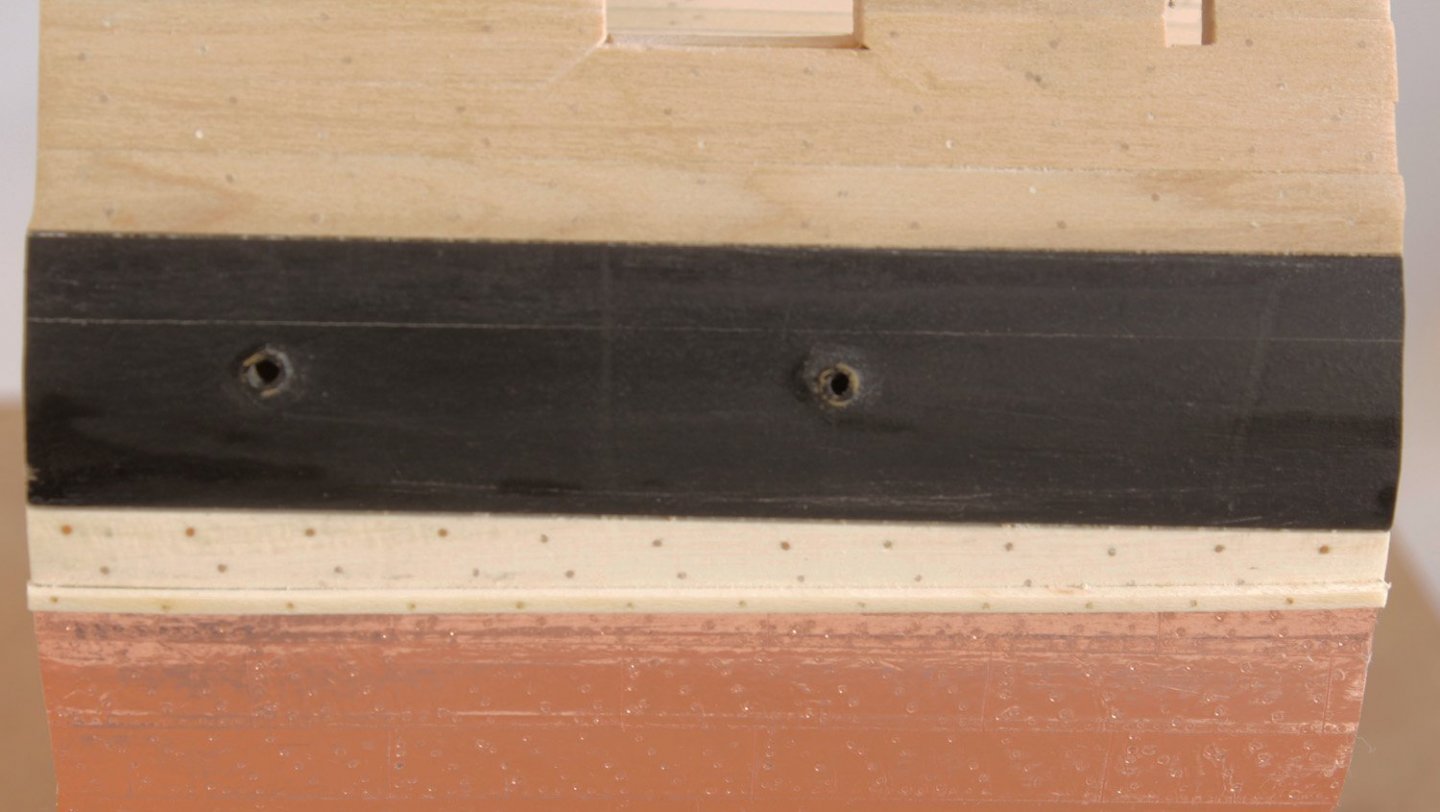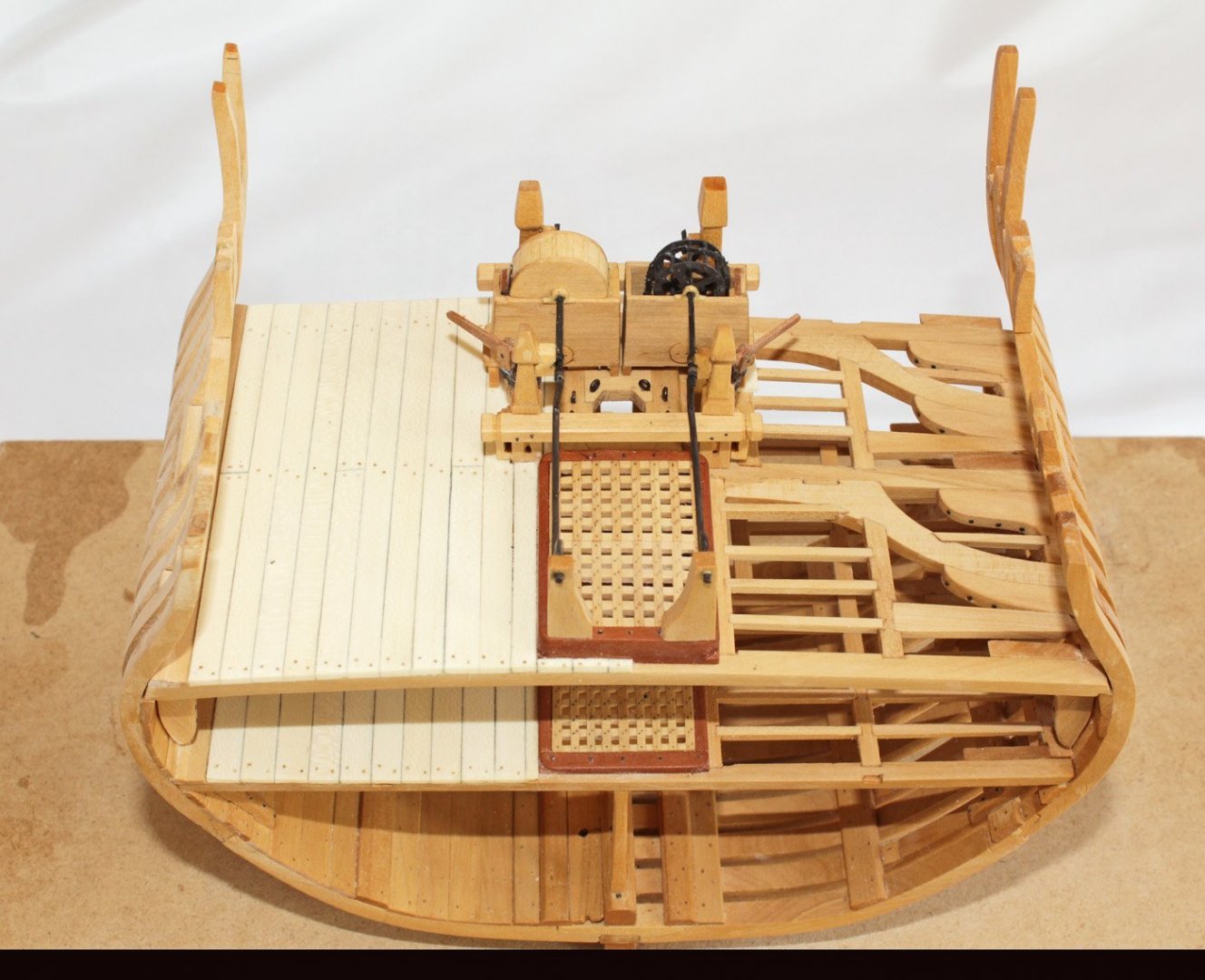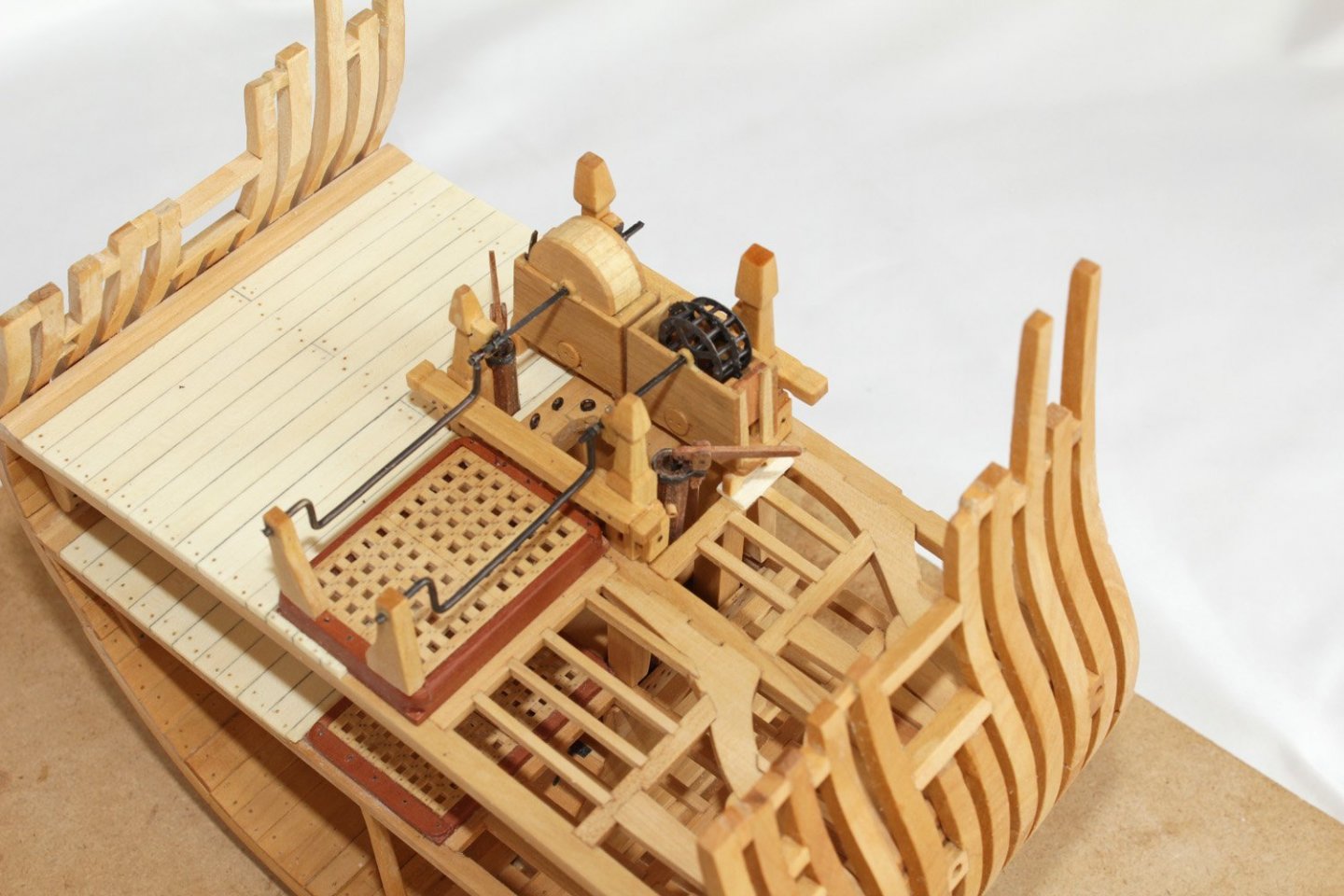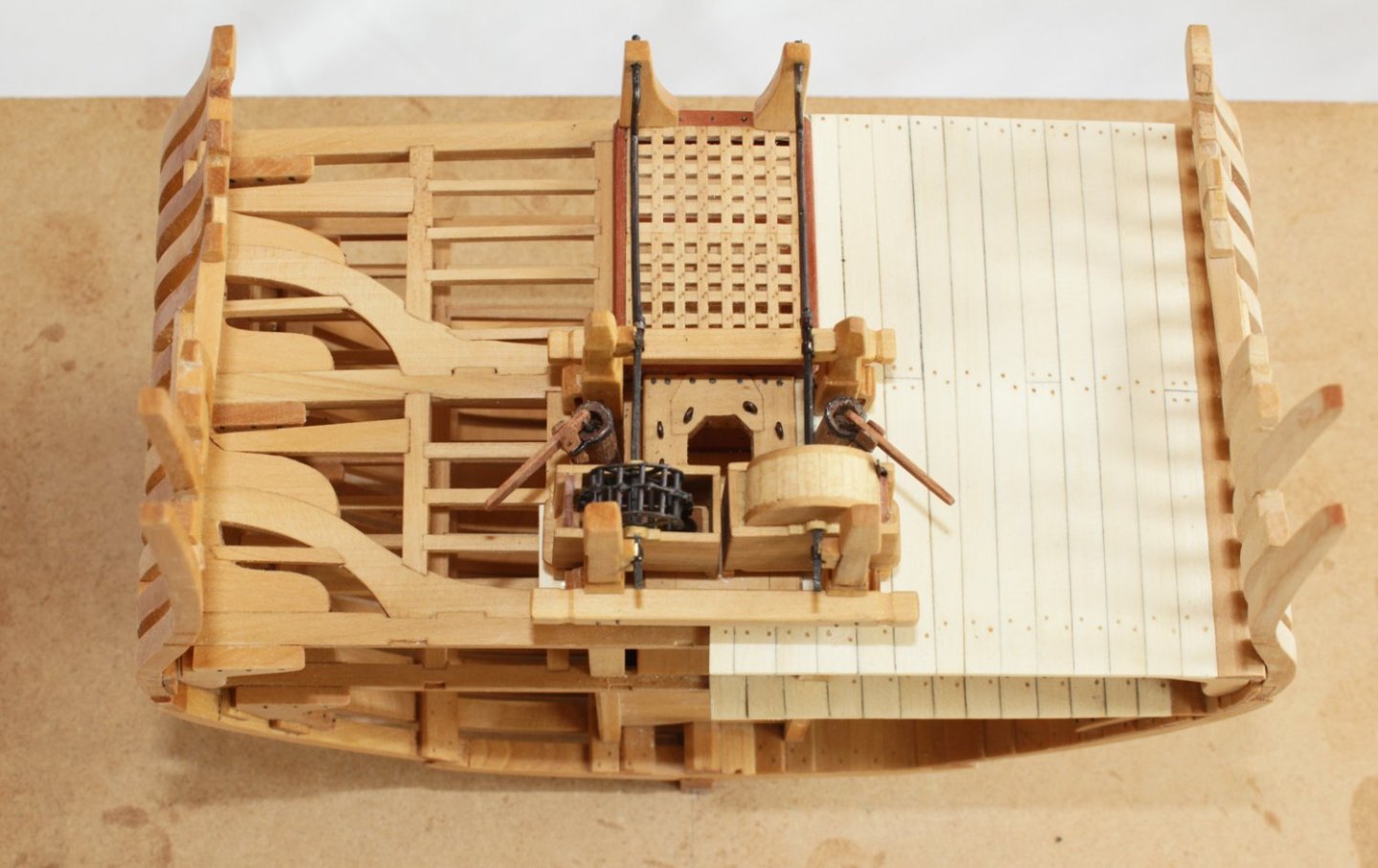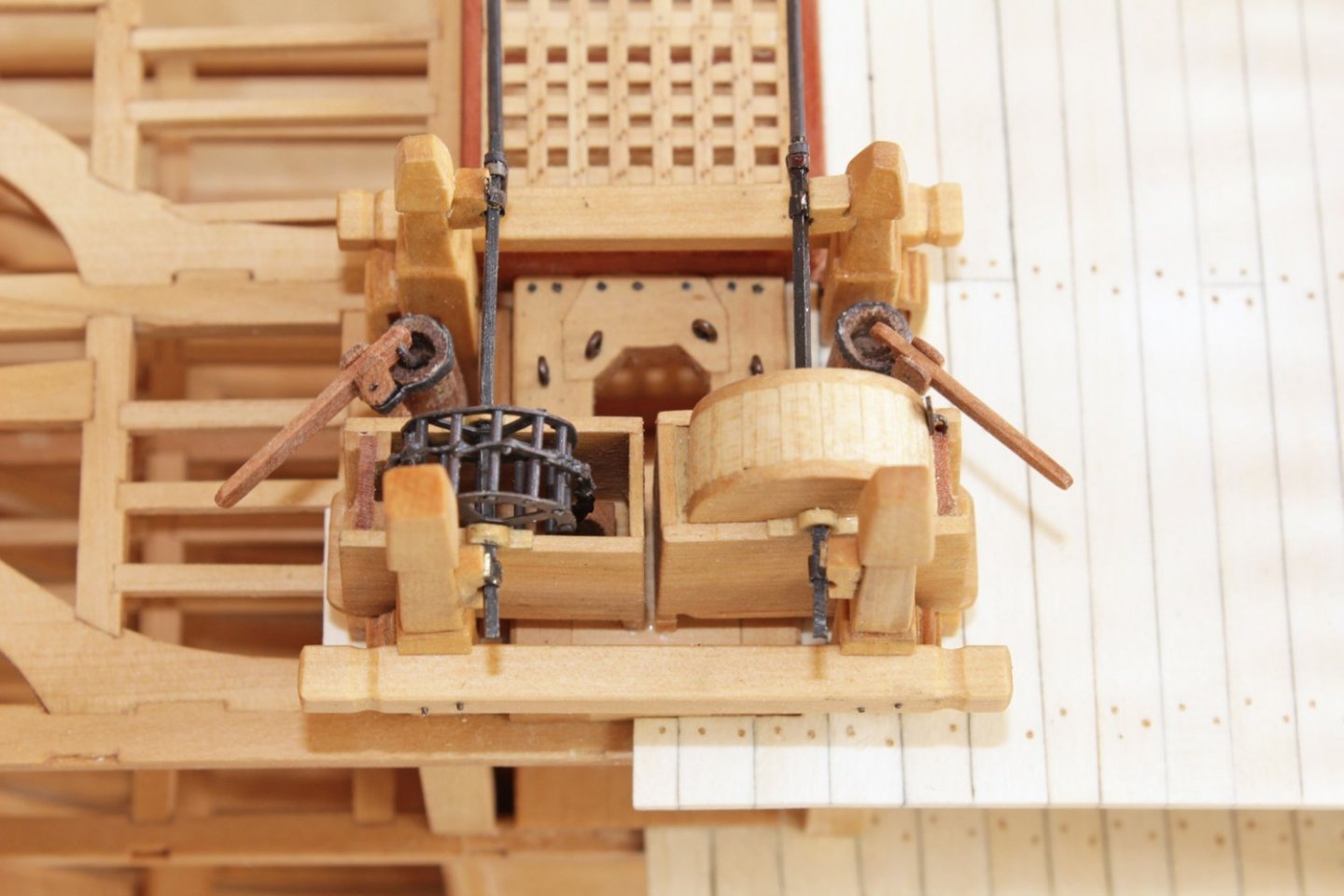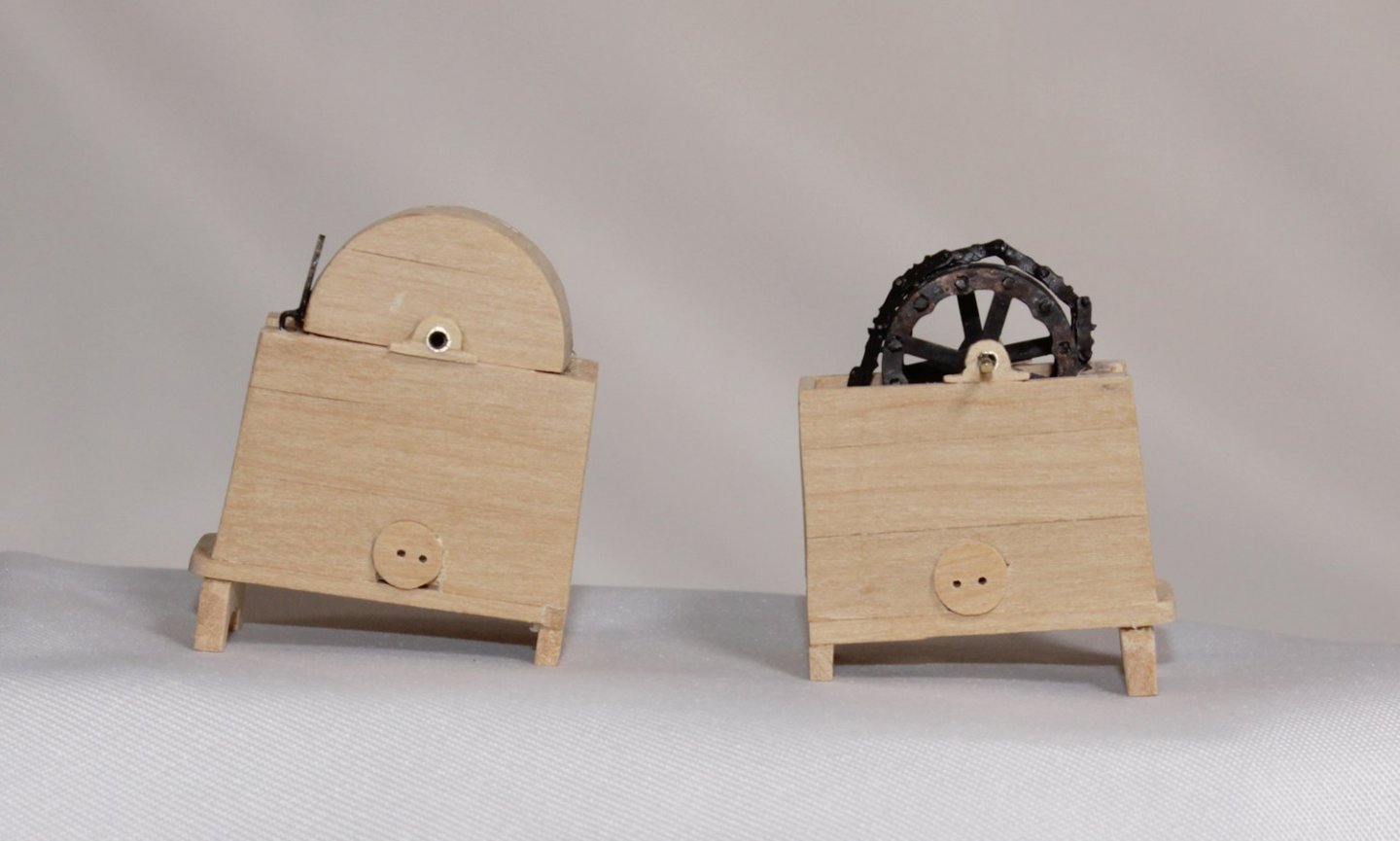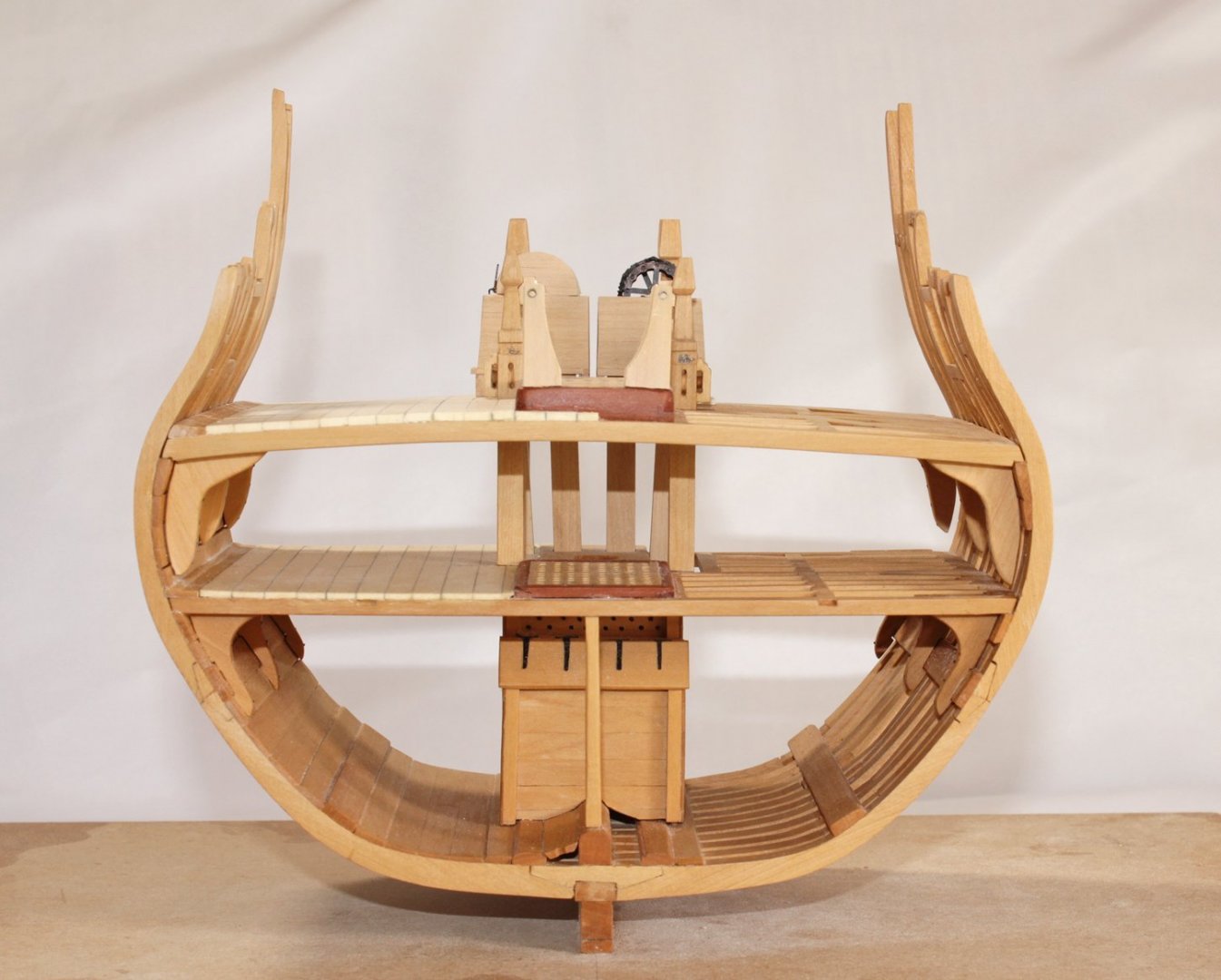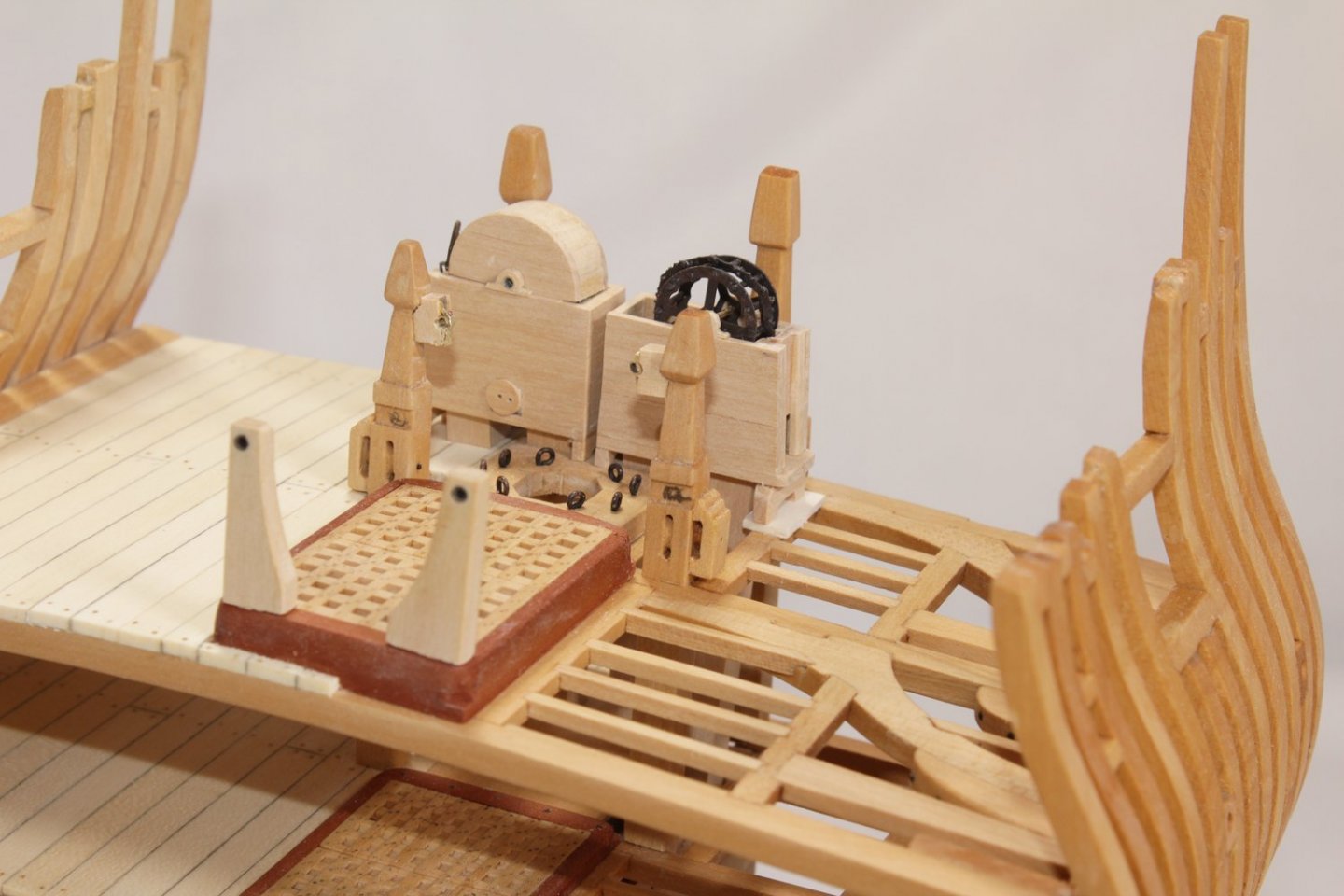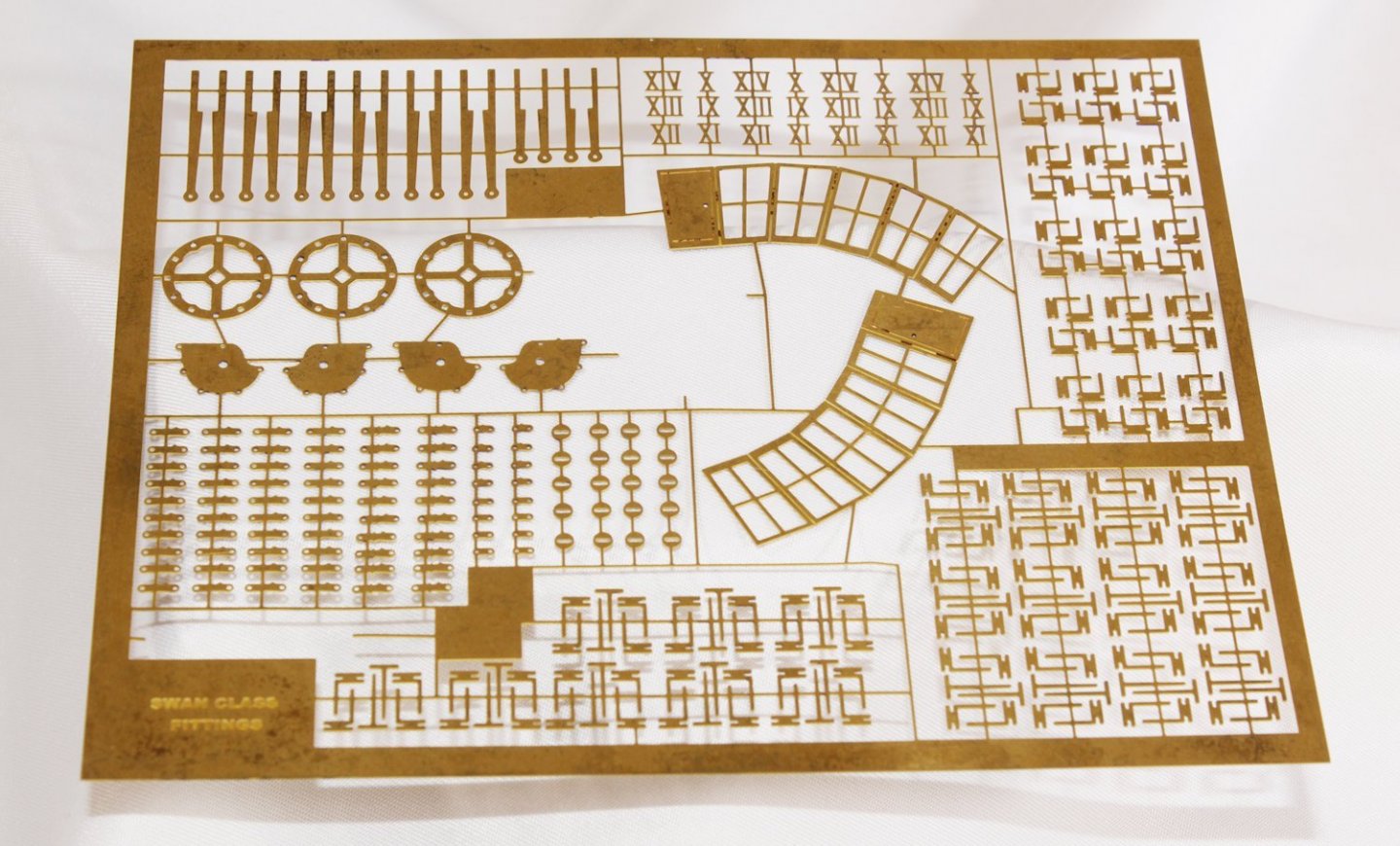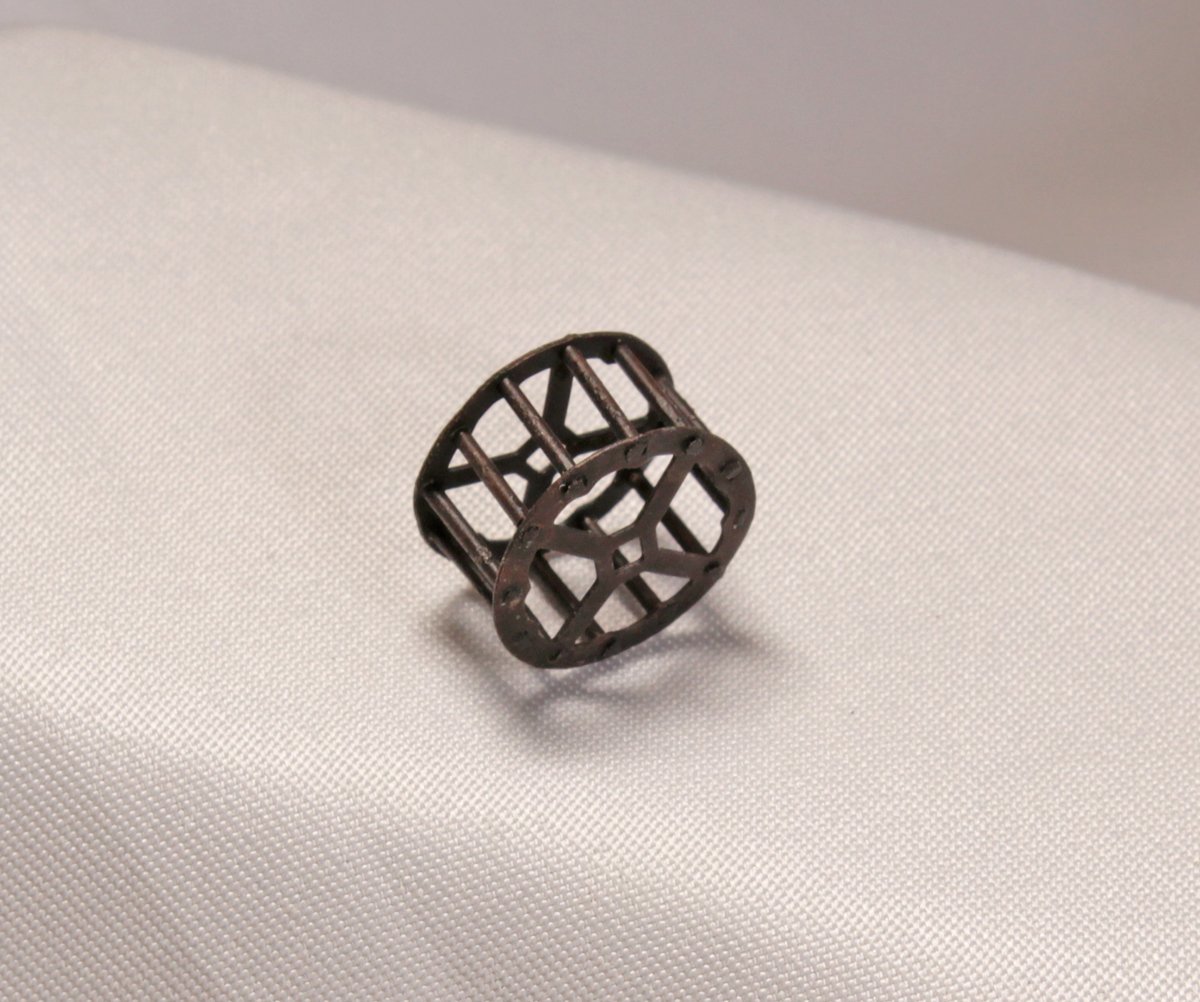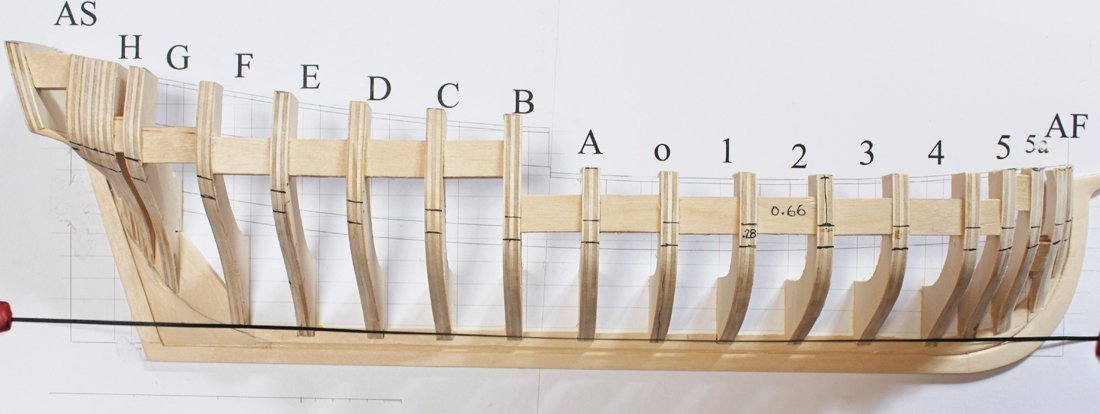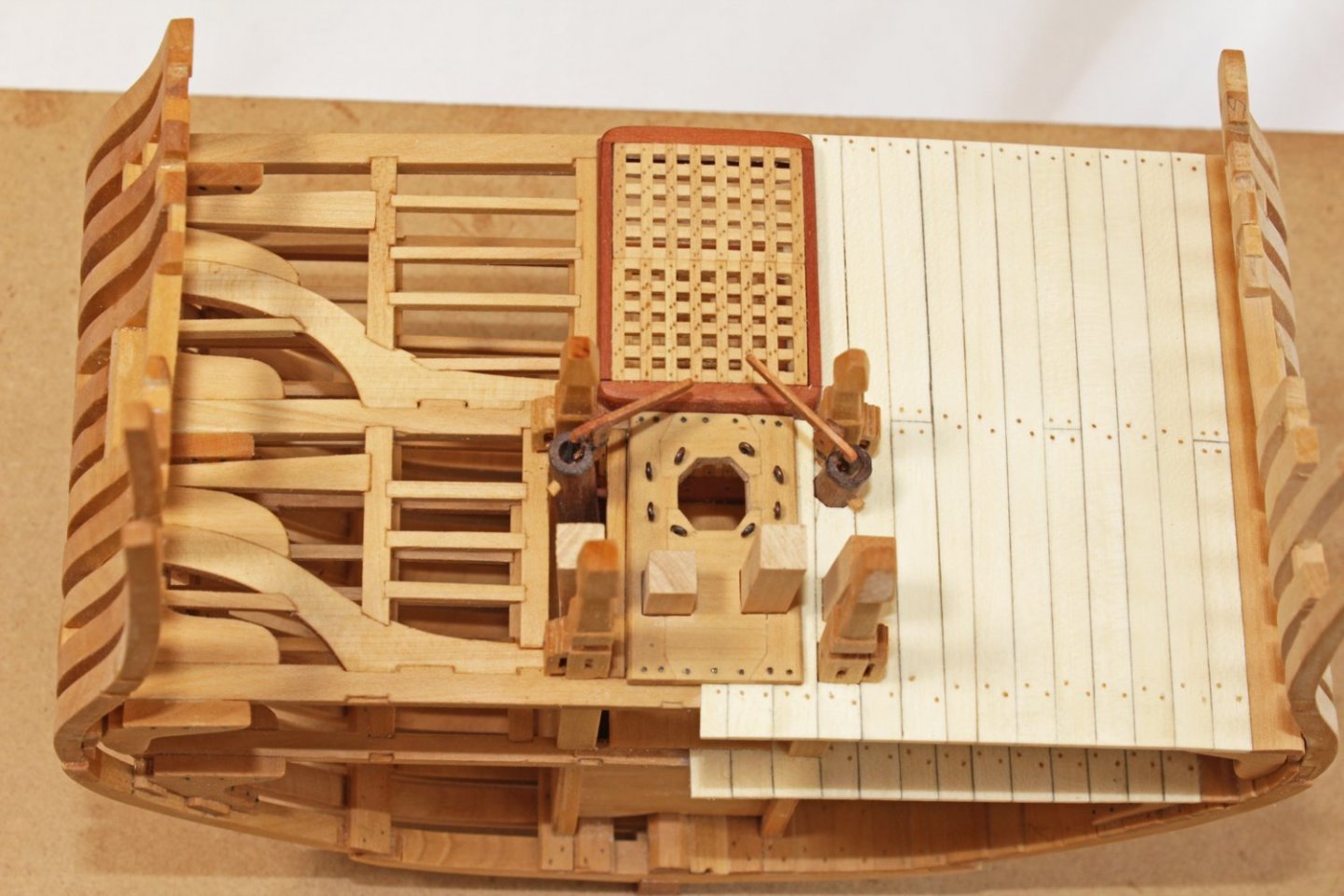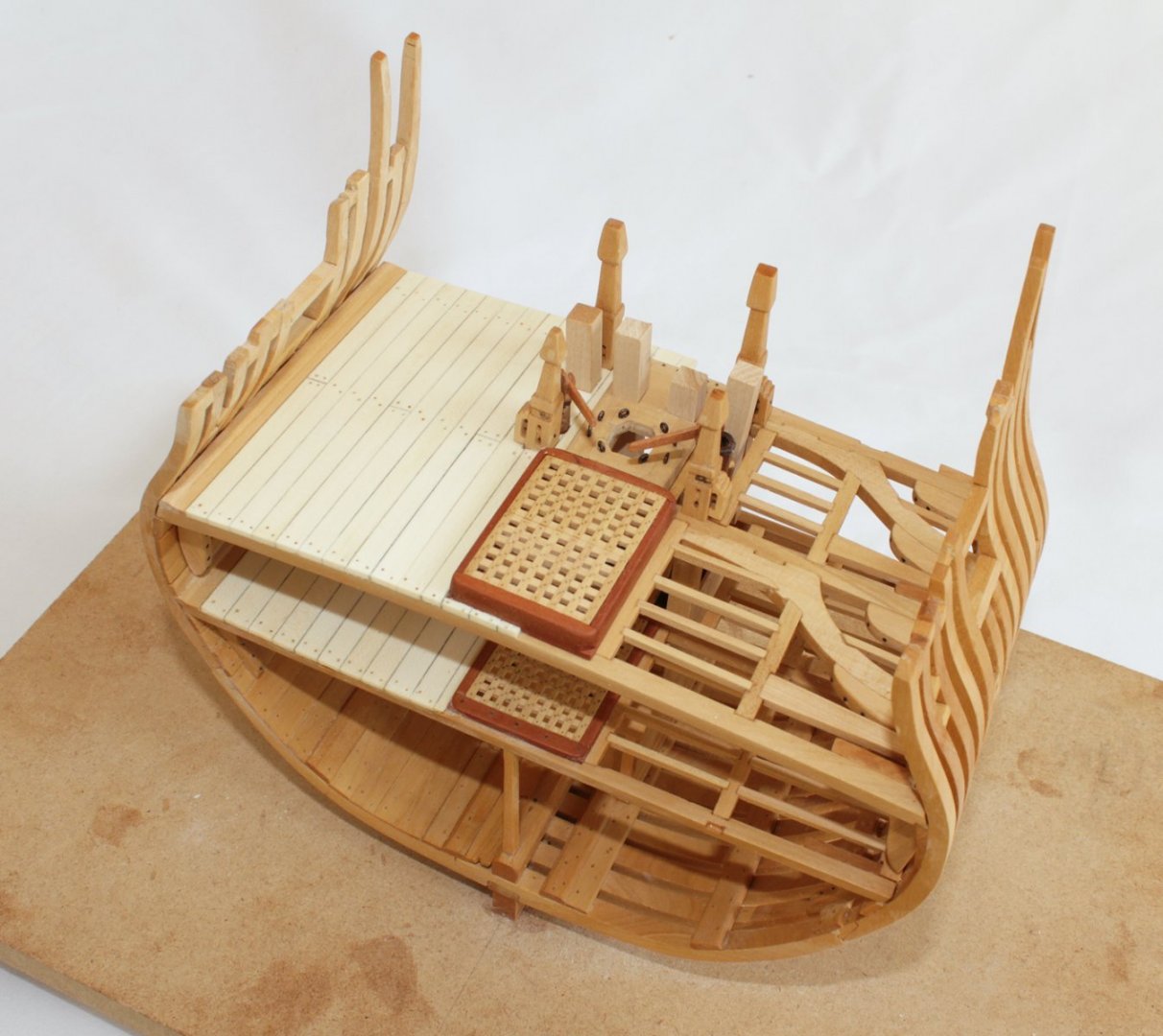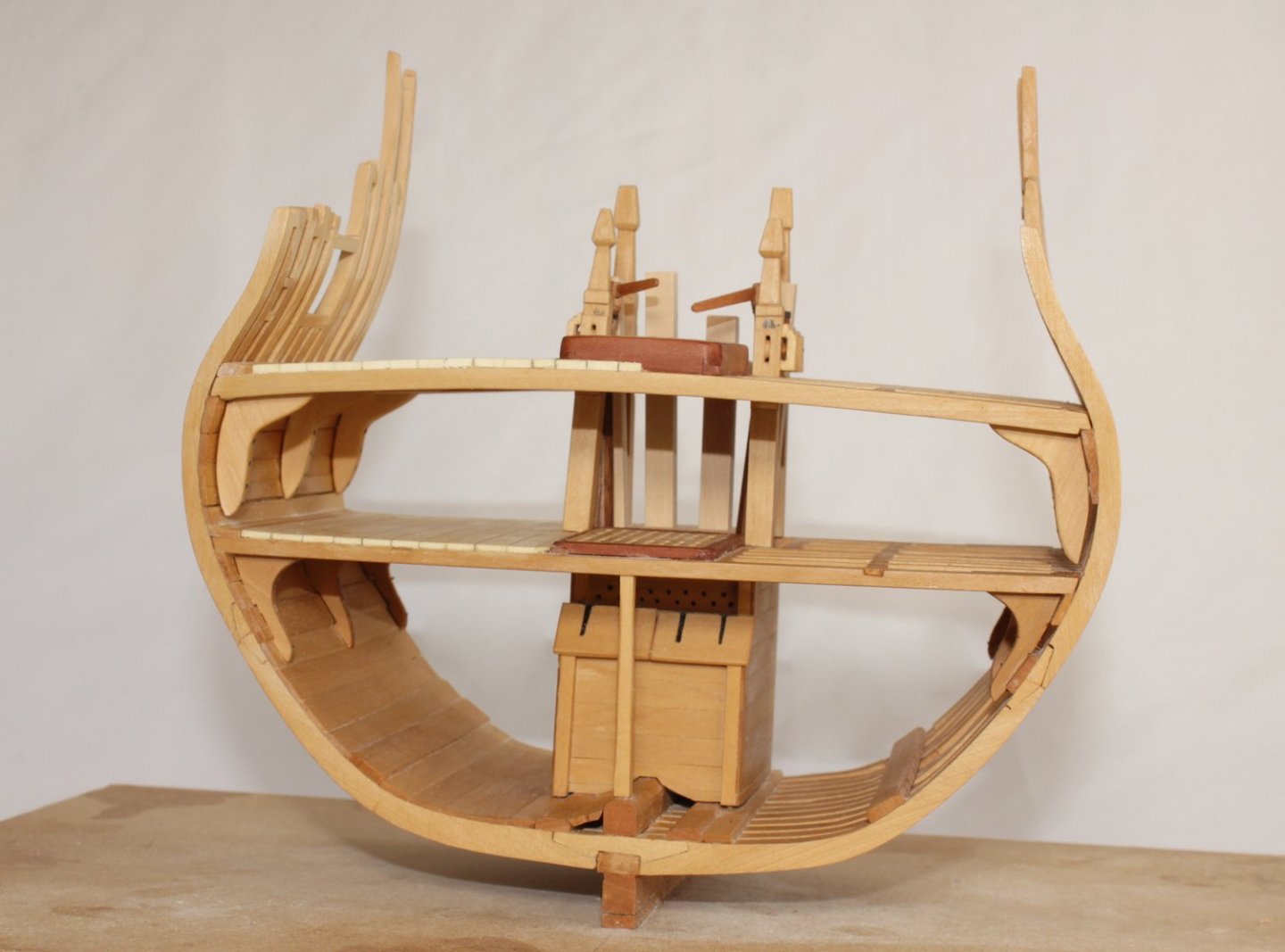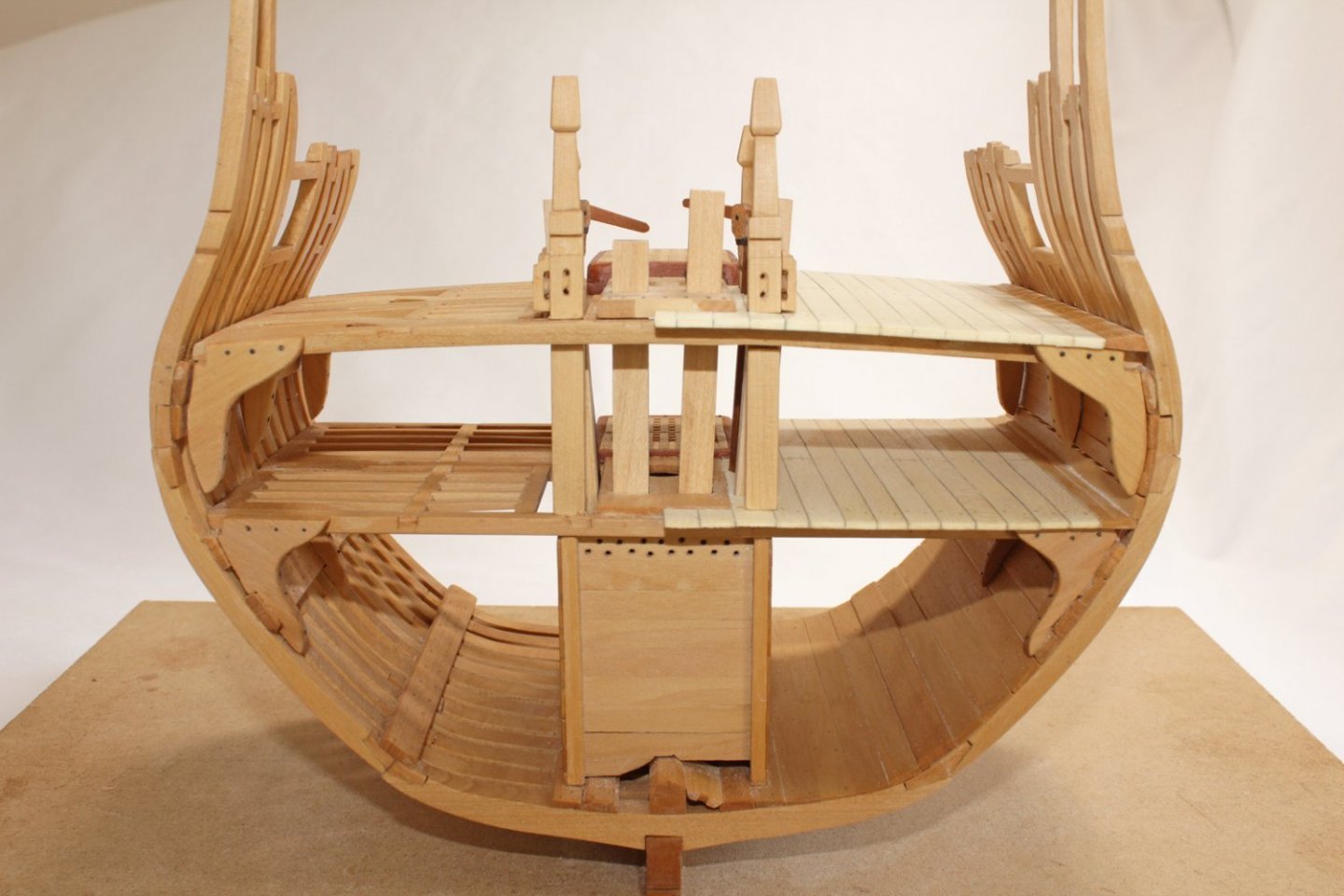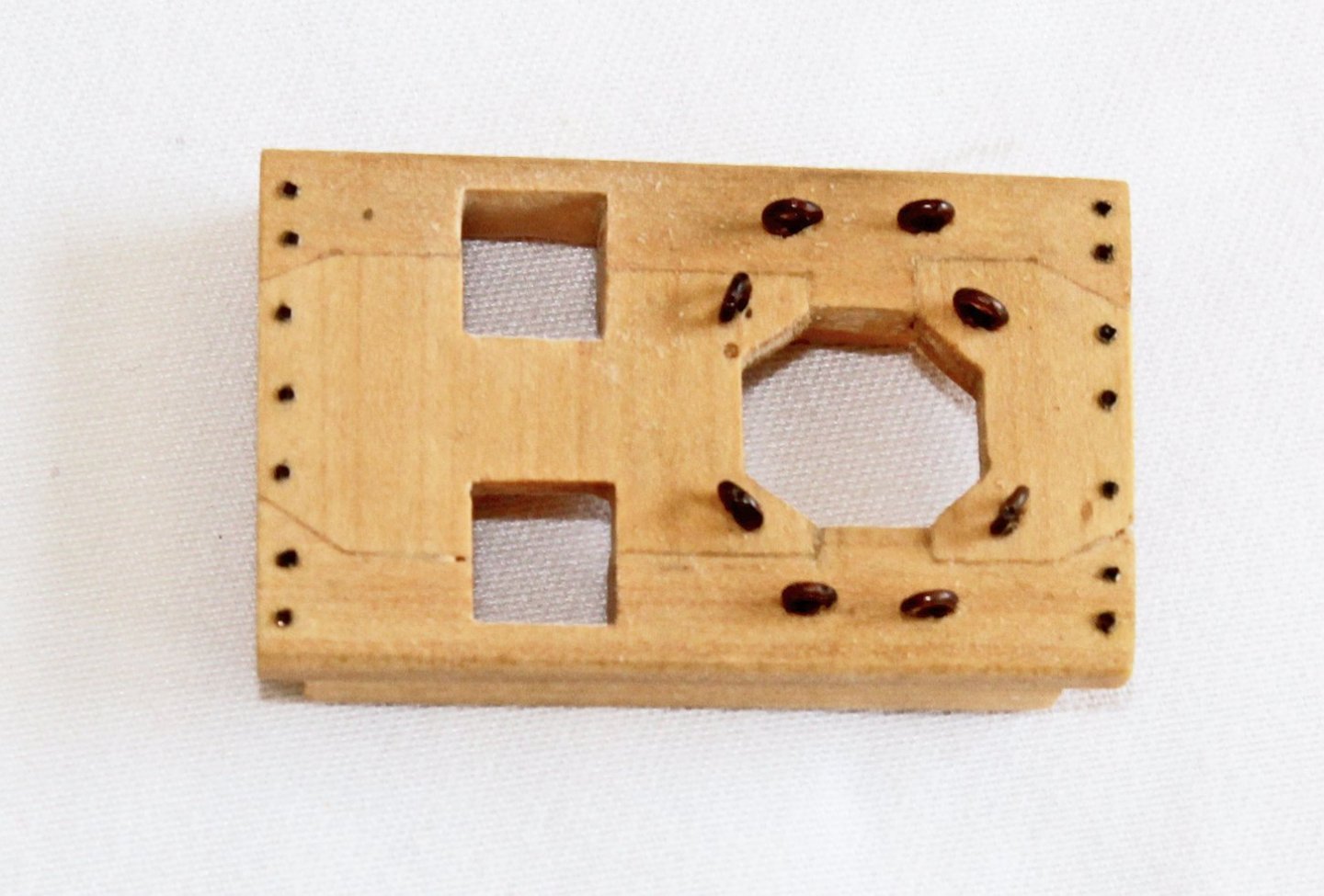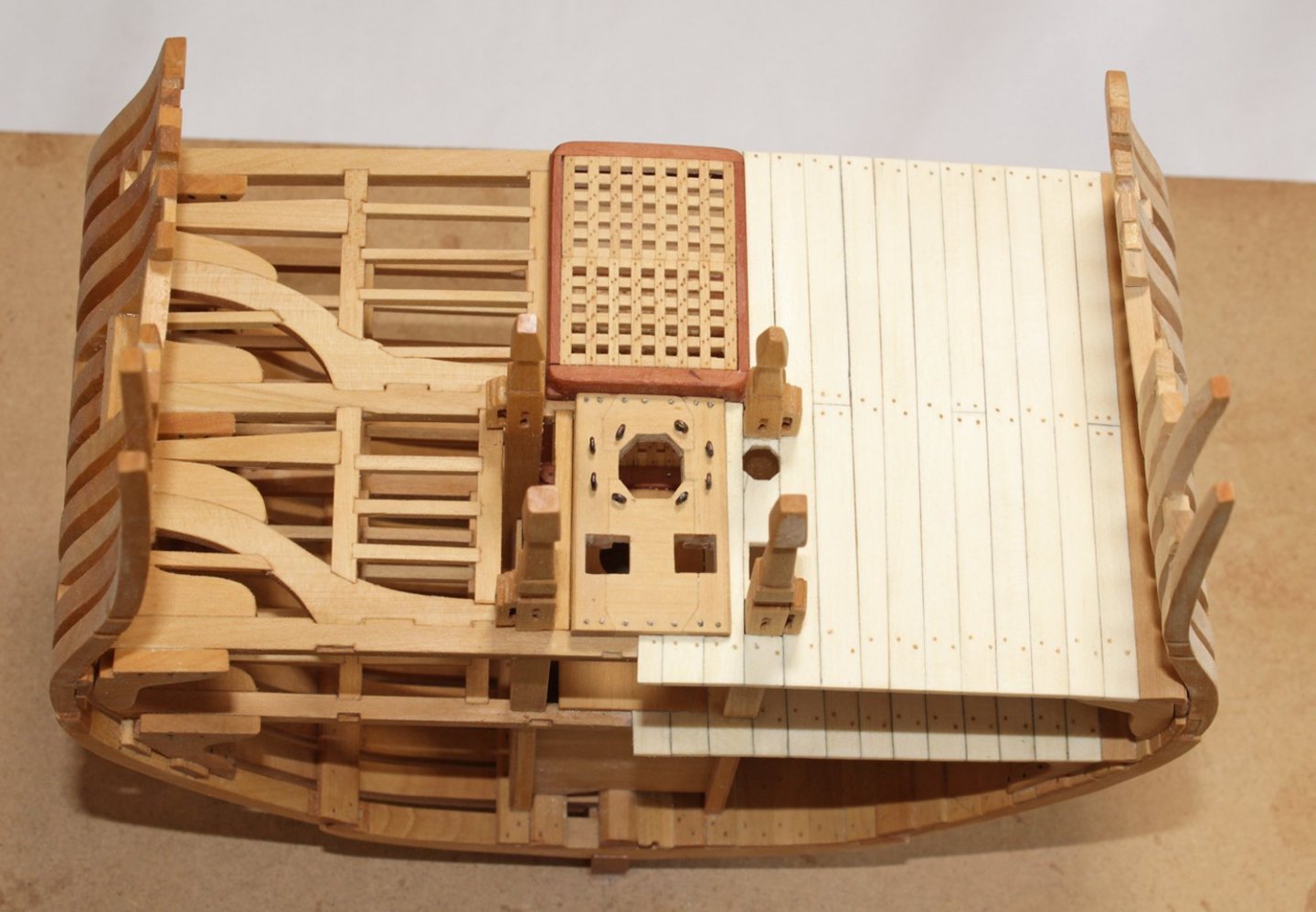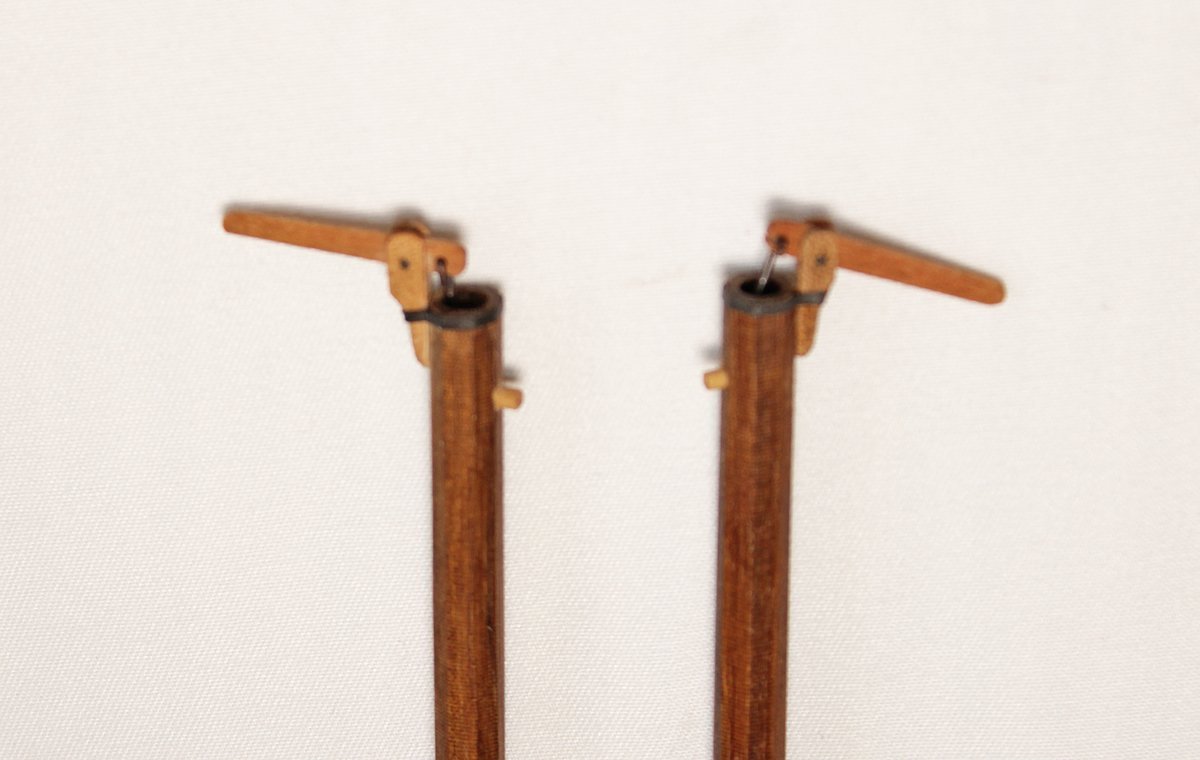-
Posts
2,032 -
Joined
-
Last visited
Content Type
Profiles
Forums
Gallery
Events
Everything posted by tlevine
-
I agree. Remove the lower strakes of planking. Then, draw the runs of the planks on the hull. This is the easiest way to determine the amount of taper required and whether stealers are needed. Remember that you never want a plank less than half the width. That is when a dropped plank would be needed.
-
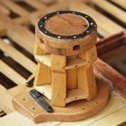
Echo by tlevine - FINISHED - Cross-Section
tlevine replied to tlevine's topic in - Build logs for subjects built 1751 - 1800
I have installed the stops around the gun port and the oar port. The gun port is framed on the bottom and sides, the oar port on all four sides. The quarter deck clamps have been installed. You can see that the stops are flush with the inner face of the frames. The inner bulwark planking is next.- 52 replies
-

HMS Bounty by AdamA - 1:48
tlevine replied to AdamA's topic in - Build logs for subjects built 1751 - 1800
Since you can drill into the table, I would recommend drilling your mounting holes and bolt the keel to it. Those clamps will not keep everything level. -

Echo by tlevine - FINISHED - Cross-Section
tlevine replied to tlevine's topic in - Build logs for subjects built 1751 - 1800
The exterior hull planking was next. I forgot to take interim pictures, sorry. The main wale was installed first. This consisted of three rows of holly planking. The upper and lower rows outer edges were tapered to match the thickness of the rest of the hull planking. The wale was painted with dilute artist acrylic. The holes are for the scupper pipes. These were made from brass sheet that was tempered and wrapped around the appropriate diameter drill bit. The long edge was soldered closed. The upper planking is castelo and the lower hull is planked in holly. Making treenails is one of the most tedious tasks I can imagine. I find it at the same level as tying ratlines. With that in mind, I decided to copper the hull. I found a picture of one of the plates removed from the Cutty Sark and used that to determine the number of nails and their pattern. At 1:48 scale, the nail heads would have been the diameter of 28 gauge wire. I tried using that initially but found that the wire kept bending so I used 26 gauge brass wire instead. So that the nail heads would not be too crowded appearing, I eliminated one of the diagonal rows of nails. Each plate is 14" x 48". The copper is conductive tape. The picture shows the nail head pattern. First, I drew the waterline onto the hull (the pencil line below the first row of hull planking). Coppering then progressed from the keel, upwards. a After the coppering was completed, I burnished the plates to make the dimpling more subtle and washed them down with isopropanol to remove any grease from my hands. The elm battern was installed overlying the top of the coppering. The inner bulwark planking is next.- 52 replies
-

Vanda-Lay treenail maker
tlevine replied to JerryC's topic in Building, Framing, Planking and plating a ships hull and deck
Try contacting Vanda-Lay. However, unless you are building 1:48 or larger, they will be over-scale sized. -

Echo by tlevine - FINISHED - Cross-Section
tlevine replied to tlevine's topic in - Build logs for subjects built 1751 - 1800
The log pumps, pump cisterns and winches have been installed. The section of the winch which goes through the cistern is square; the rest is round. I could not find a short piece of brass rod to fabricate this from (and my purchasing option was for 20+ feet), so this section was made from castelo, dyed black with archival ink. Round brass rod was annealed and bent into shape. Repeated heating and hammering the piece against the edge of a machinist square gave me reasonably sharp corners. Brass tube was soldered onto the aft end. This was blackened and threaded onto the square rod. The winch actually extends beyond the area of the cross-section and was therefore cut off at the edge of the model fore and aft. Next is the exterior hull planking.- 52 replies
-
This sheer plan is for Atalanta but they were of the same class, with very little difference between them. https://commons.wikimedia.org/wiki/File:Atalanta_(1775)_RMG_J4428.png Even with volumes I and II of TFFM, without a set of plans, you will not be successful in building Pegasus.
- 257 replies
-
- pegasus
- Swan-class
-
(and 1 more)
Tagged with:
-

Echo by tlevine - FINISHED - Cross-Section
tlevine replied to tlevine's topic in - Build logs for subjects built 1751 - 1800
The next items to be make are the cisterns and winches. I decided to show the starboard cistern with its hood and the port cistern open, showing the sprocket wheel and chain. The cisterns are straight forward in their construction. They are simply a box with openings in the bottom for the pumps, and a slide on the outboard side to allow insertion of the pump dale. The inboard legs rest on the mast step and the outboard ones are on the deck. I was lucky enough to have a sheet of photo etch from Admiralty Models developed for the Swan class. They are no longer available. I used this for the sprocket wheel. The photoetch sheet has the rim of the wheel; short lengths of brass wire were silver soldered to them. I also made a segment of chain from pieces of the same photoetch sheet. The next photo shows my tipsy cisterns. The drainage plugs are in place. A rope handle in the plug will be added later. The chain was lifted up to illustrate the detail in the photoetch. The winch assembly is supported by rhodings on the cistern hood, bitt pins and end support pillars. The hood and pillar rhodings are repesented by brass tubing. Those on the bitt pins are inset into a spacer block, as seen in the last photo. These will all be blackened.- 52 replies
-
This is the picture from the manual. As you can see, either the top or the bottom of the wale is accessible with a machinist's square...or at least my machinist's square. As stated in the instructions, "...mark the top and/or bottom of the wale. This is indicated by curved blue lines on the plan. Unlike the planking on the lower hull, the width of the wale is the constant throughout its length..." Comparing your photo with this one, the only difference I see is that the spacers mid-hull are higher on mine. Looking at your half-hull, I would suggest running either a plank or tape along bulkheads aft of F. In the picture you posted, it looks like more fairing will be required.
-
Looks great, Eric. The concept behind the project was to help remove the fear of scratch building. What's next?
-

NAIAD 1797 by Bitao - 1:60
tlevine replied to Bitao's topic in - Build logs for subjects built 1751 - 1800
Most importantly, your work is incredible. I wish I had half your talent. I agree with you that the color of the wales is too brown. How are you planning on fixing it? -

Echo by tlevine - FINISHED - Cross-Section
tlevine replied to tlevine's topic in - Build logs for subjects built 1751 - 1800
I should have mentioned this earlier. For anybody considering this model, I have one word of advise. Do not measure off the practicum. Unlike the drawings in TFFM, these drawings are off scale by up to +/- 6%. I initially thought it was my printer but after three printers gave me the same error... If you need to make a template, import the plan into a CAD or drawing program and, using the measurements cited in the text scale the image as needed to get the correct scale.- 52 replies
-

Echo by tlevine - FINISHED - Cross-Section
tlevine replied to tlevine's topic in - Build logs for subjects built 1751 - 1800
Thanks for all the likes. Greg, I also had problems with the locations of the pumps extending into the well. I adjusted the brake pumps location to compensate. I had to do the same thing with the outer chain pumps. The port pump extends all the way down to the channel. I truncated the starboard one for the simple reason that I ran out of wood and did not want to make up another one. The chain pump boxes extend all the way down.- 52 replies
-

Echo by tlevine - FINISHED - Cross-Section
tlevine replied to tlevine's topic in - Build logs for subjects built 1751 - 1800
I have had a little more time to work on Echo. The upper deck planking has been laid. Parts of it were laid twice since I forgot to locate the openings for the pump tubes. And speaking of making things twice, my new motto is measure three times, cut once. I discovered that somehow the location of the chain pump openings in the mast step was off by 1/8". I am happier with the remade step anyway. The ringbolts have been installed surrounding the mast opening. The next step was to begin installation of the pumps. There are a pair of brake pumps and a pair of chain pumps. Temporary chain pump cases have been installed. You can see from the picture that they are vertical but form a V-shape when viewed fore-to-aft. The brake pumps are octagonal. I made these in the V-jig that is normally used to shape masts. A chisel was used to knock down the corners of a square blank the final shape was obtained with a sanding stick. The pump was bored by chucking it on the lathe and putting a drill bit in the tail stock. A second hole was drilled for the discharge spout. I wanted a color contrast; they were made from apple. I apologize for the out of focus picture. The pumps are temporarily installed. Next up is the cover and winch for the chain pump.- 52 replies
-
For anyone who purchased this project, the revised plan set it available from the office. Just drop Mary a note at info@thenauticalresearchguild.org.
-
First, new drawings have been made of the coamings, gratings and capstan step. The original drawings will work; it simply will not look like the prototype. I will be submitting them to the office so that they can be distributed to anyone who has purchased the project. If you need them sooner, send me a pm. Second, my directions describe how I made them. You are right; pieces of wood 7" x 3 7/8" and 5 5/8" x 4 1/4" would work. Feel free to use different sized wood to get the same result. The extra 1/4" gives me a little "breathing room" to sand the wedges to the final dimensions. It is much easier to take off wood than to put it back. The whole idea is to have alternating wedges so that the whelps fit securely onto a flat surface and are evenly spaced. The recesses made with the alternating wedges is only 1/16".
About us
Modelshipworld - Advancing Ship Modeling through Research
SSL Secured
Your security is important for us so this Website is SSL-Secured
NRG Mailing Address
Nautical Research Guild
237 South Lincoln Street
Westmont IL, 60559-1917
Model Ship World ® and the MSW logo are Registered Trademarks, and belong to the Nautical Research Guild (United States Patent and Trademark Office: No. 6,929,264 & No. 6,929,274, registered Dec. 20, 2022)
Helpful Links
About the NRG
If you enjoy building ship models that are historically accurate as well as beautiful, then The Nautical Research Guild (NRG) is just right for you.
The Guild is a non-profit educational organization whose mission is to “Advance Ship Modeling Through Research”. We provide support to our members in their efforts to raise the quality of their model ships.
The Nautical Research Guild has published our world-renowned quarterly magazine, The Nautical Research Journal, since 1955. The pages of the Journal are full of articles by accomplished ship modelers who show you how they create those exquisite details on their models, and by maritime historians who show you the correct details to build. The Journal is available in both print and digital editions. Go to the NRG web site (www.thenrg.org) to download a complimentary digital copy of the Journal. The NRG also publishes plan sets, books and compilations of back issues of the Journal and the former Ships in Scale and Model Ship Builder magazines.



